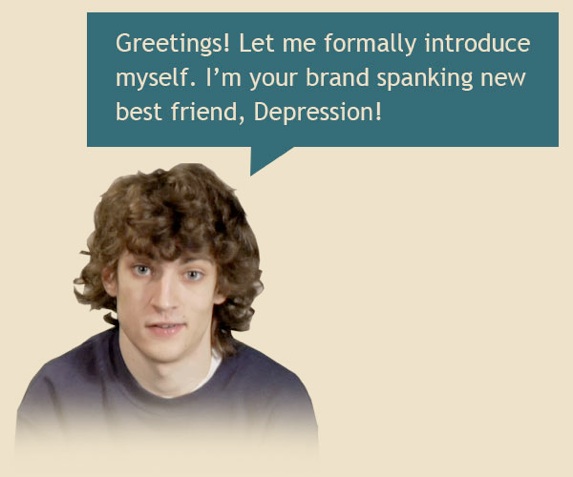Latest Public Service Radio Minute
Loss of EmploymentLoss of Employment, MP3, 1.3MB
Listen to or download all our PSAsSupport Our Work
Please donate so we can continue our work to reduce the stigma of psychiatric illness, encourage research, and support educational activities for behavioral health professionals and the public. Ways you can donate and help are on our Support and Donations page. Thank you!
More InfoLatest News Around the Web
Heavy Drinking May Fuel Men’s Suicide Risk During Economic Downturns
HealthDay (5/26, Preidt) reports, “Heavy drinking may fuel the risk of suicide among men when the economy is sinking,” research published in the July issue of Alcoholism: Clinical and Experimental Research suggests. Researchers arrived at the study’s conclusions after analyzing “data from 16 states to compare alcohol use between suicide victims and the general population in 2005-2007, during the 2008-2009 recession, and again in 2010-2011.”
Related Links:
— “Tough Economy, Alcohol Fuels Suicide Risk in Men: Study,” Robert Preidt, HealthDay, May 26, 2016.
Patients Who Attempt Suicide Four Or More Times Have Higher Risk Of Success
Medscape (5/26, Brooks) reports, “Depressed patients who attempt suicide four or more times have a higher risk of eventually dying by suicide compared with their depressed peers who have never attempted suicide or who have done so fewer times,” research suggests. The findings of the 683-patient study were presented at the American Psychiatric Association’s annual meeting. Meanwhile, APA president and study coauthor Maria Oquendo, MD, said “physicians need to ‘readjust their view of the multiple suicide attempter as someone who is just trying to get attention.” She added, “One of the things I tell my students is, you really shouldn’t use the term ‘suicide gesture’ because it trivializes the behavior of that individual, and if you can help get them through their rough patch, you might just save a life.”
Related Links:
— Medscape (requires login and subscription)
Risk Of Suicide Attempts Made By Enlisted Soldiers Varies Over Time
Reuters (5/25, Seaman) reports a study published online May 25 in JAMA Psychiatry suggests that the risk of suicide attempts made by enlisted soldiers in the US Army appears to vary over time.
The ABC News (5/25, Mohney) website reports that after examining “data from 163,178 enlisted soldiers,” researchers found that “enlisted soldiers, who had never been deployed, accounted for 61.1 percent of the enlisted soldiers who attempted suicide.” Soldiers among that group faced the “highest” risk for a “suicide attempt…when they reached their second month of service.” Soldiers who were deployed appeared to be “at highest risk six months into deployment.” And, among soldiers who had returned home from a previous deployment, “five months after getting back home was their highest risk time” for making a suicide attempt.
Related Links:
— “In U.S. Army, enlisted soldiers’ risk of suicide attempts varies over time,” Andrew W. Seaman, Reuters, May 25, 2016.
Severely Obese Children Picked On, Bullied More Than Normal-Weight Kids
HealthDay (5/25, Reinberg) reports, “As early as first grade, severely obese children are getting teased, picked on and bullied more than normal-weight kids,” research published online May 25 in Child Development indicates. Researchers arrived at this conclusion after gathering “data on nearly 1,200 first graders from 29 rural schools in Oklahoma.”
Medical Daily (5/25, Bushak) reports that youngsters “in general, including non-obese kids, rarely mentioned obese children as being a favorite classmate or playmate compared to non-obese kids.” What’s more, kids who were “severely obese…were more likely to be teased or ostracized and to show symptoms of depression.” Children “who were severely obese had it worse than those who were simply overweight.”
Related Links:
— “‘Fat Shaming’ Begins in First Grade,” Steven Reinberg, HealthDay, May 25, 2016.
Graduated Extinction Sleep Training In Infants Appears To Cause No Long-Term Harm
USA Today (5/24, Bowerman) reports that “letting a baby cry it out, or cry until the child drifts off to sleep, does not cause long-term emotional or behavioral harm,” the findings of a study published online May 24 in Pediatrics suggest. After testing “the controversial sleep method of crying it out, and another commonly used sleep method on a group of 43 infants spanning from six months to 16 months,” investigators learned that babies “whose parents used ‘graduated extinction,’ or those who allowed their child to cry for increasingly long periods of time, were no more stressed than babies whose parents used bedtime fading, or the technique of moving bedtime later in hope that the child will fall asleep more quickly.”
In the New York Times (5/24) “Well” blog, Perri Klass, MD, writes that while graduated extinction and bedtime fading both “decreased the time it took children to fall asleep and graduated extinction reduced night wakings,” there is no seeming evidence that “you do harm by deciding to forgo ‘sleep training’ and waiting for the child to outgrow the night waking – as long as that doesn’t damage your marriage or your mental health.”
Related Links:
— “Study: Letting baby ‘cry it out’ won’t cause damage,” Mary Bowerman, USA Today, May 27, 2016.
Foundation News
Nothing Found
It seems we can’t find what you’re looking for. Perhaps searching can help.

